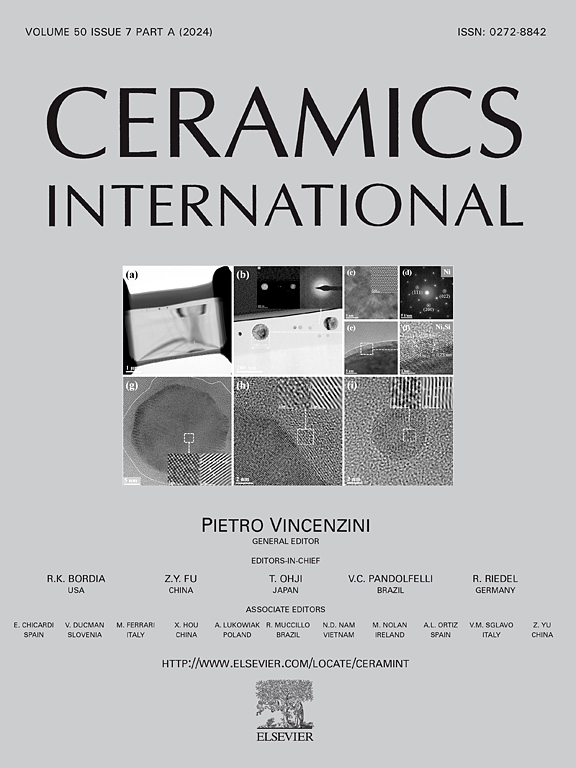揭示具有出色热稳定性的 BaLaLiTeO6:Dy3+ 双包晶的光物理响应,用于彩色可调发光二极管和光学温度计
IF 5.1
2区 材料科学
Q1 MATERIALS SCIENCE, CERAMICS
引用次数: 0
摘要
随着对高性价比、高性能多功能荧光粉的需求日益增长,对可靠荧光粉的追求也在加速。在双包晶型荧光粉中加入热计量应用可以增强荧光粉的多方面特性,从而实现多样化应用。本研究致力于通过固态反应路线开发一系列 BaLaLiTeO6:Dy3+ 双包晶石,强调它们在下一代颜色可调 LED 和非接触式发光测温仪中的应用。通过 X 射线衍射、拉曼和傅立叶变换红外光谱分析,推断了在 BaLaLiTeO6 的 La3+ 位点取代 Dy3+ 所引起的结构变化。通过漫反射光谱、光致发光光谱和衰减曲线分析,对光学特性进行了广泛的研究。此外,还对主要的光度参数进行了评估,以评估所开发的荧光粉在光子应用中的商业可行性。根据 BaLaLiTeO6:Dy3+ 的光致发光激发光谱,首次估算出了 Judd-Ofelt 参数。此外,辐射参数、荧光衰减时间和量子效率的数值表明,所开发的荧光粉适合用作合格材料。通过温度依赖性光致发光光谱,对 BaLaLiTeO6:Dy3+ 作为热成像荧光粉进行了全面分析。通过估算基于荧光强度比(FIR)的测温数字,探究了这种材料在发光温度传感方面的潜在用途。在 500 K 的温度下,绝对灵敏度达到 22.17 × 10-4 K-1,在 250 K 的温度下,相对灵敏度达到 2.34 %K-1,远高于其他 Dy3+ 取代的热成像荧光粉。BaLaLiTeO6:Dy3+ 荧光粉的所有这些特点都证明了它们在热稳定彩色可调 LED、wLED 和非接触式光学温度传感器中的应用前景。本文章由计算机程序翻译,如有差异,请以英文原文为准。
Unraveling the photophysical response of BaLaLiTeO6:Dy3+ double perovskites with excellent thermal stability for colour tunable LEDs and optical thermometry
The quest for reliable phosphors has accelerated amidst a growing demand for cost-effective, high-performance multifunctional phosphors. Incorporating thermometric application into double perovskite phosphors can enhance their multifaceted features for diverse applications. The present work endeavours to develop a series of BaLaLiTeO6:Dy3+ double perovskites via a solid-state reaction route, stressing their application in next-generation colour-tunable LEDs and non-contact luminescence thermometry. X-ray diffraction, Raman and FTIR spectroscopy analysis were done to make inferences about the structural modifications induced by the substitution of Dy3+ at the La3+ site of BaLaLiTeO6. An extensive investigation of optical characteristics was carried out by diffuse reflectance spectroscopy, photoluminescence spectroscopy and decay curve analysis. Prominent photometric parameters were also evaluated to assess the commercial feasibility of the developed phosphors in photonic applications. Judd-Ofelt parameters were estimated from the photoluminescence excitation spectra of BaLaLiTeO6:Dy3+ for the first time. Furthermore, the values of radiative parameters, fluorescence decay time and quantum efficiency suggested the suitability of the developed phosphor as a competent material. A comprehensive analysis of BaLaLiTeO6:Dy3+ as a thermographic phosphor was done by temperature-dependent photoluminescence spectroscopy. The potential use of this material in luminescence temperature sensing was probed by estimating the thermometric figures of merit based on the fluorescence intensity ratio (FIR). An absolute sensitivity of 22.17 10−4 K−1 was achieved at a temperature of 500 K and a remarkable maximum relative sensitivity of 2.34 %K−1 was attained at 250 K, which is much higher than other Dy3+ substituted thermographic phosphors. All these culminated features of BaLaLiTeO6:Dy3+ phosphor proved their prospective applications in thermally stable colour-tunable LEDs, wLEDs and as non-contact optical temperature sensors.
求助全文
通过发布文献求助,成功后即可免费获取论文全文。
去求助
来源期刊

Ceramics International
工程技术-材料科学:硅酸盐
CiteScore
9.40
自引率
15.40%
发文量
4558
审稿时长
25 days
期刊介绍:
Ceramics International covers the science of advanced ceramic materials. The journal encourages contributions that demonstrate how an understanding of the basic chemical and physical phenomena may direct materials design and stimulate ideas for new or improved processing techniques, in order to obtain materials with desired structural features and properties.
Ceramics International covers oxide and non-oxide ceramics, functional glasses, glass ceramics, amorphous inorganic non-metallic materials (and their combinations with metal and organic materials), in the form of particulates, dense or porous bodies, thin/thick films and laminated, graded and composite structures. Process related topics such as ceramic-ceramic joints or joining ceramics with dissimilar materials, as well as surface finishing and conditioning are also covered. Besides traditional processing techniques, manufacturing routes of interest include innovative procedures benefiting from externally applied stresses, electromagnetic fields and energetic beams, as well as top-down and self-assembly nanotechnology approaches. In addition, the journal welcomes submissions on bio-inspired and bio-enabled materials designs, experimentally validated multi scale modelling and simulation for materials design, and the use of the most advanced chemical and physical characterization techniques of structure, properties and behaviour.
Technologically relevant low-dimensional systems are a particular focus of Ceramics International. These include 0, 1 and 2-D nanomaterials (also covering CNTs, graphene and related materials, and diamond-like carbons), their nanocomposites, as well as nano-hybrids and hierarchical multifunctional nanostructures that might integrate molecular, biological and electronic components.
 求助内容:
求助内容: 应助结果提醒方式:
应助结果提醒方式:


